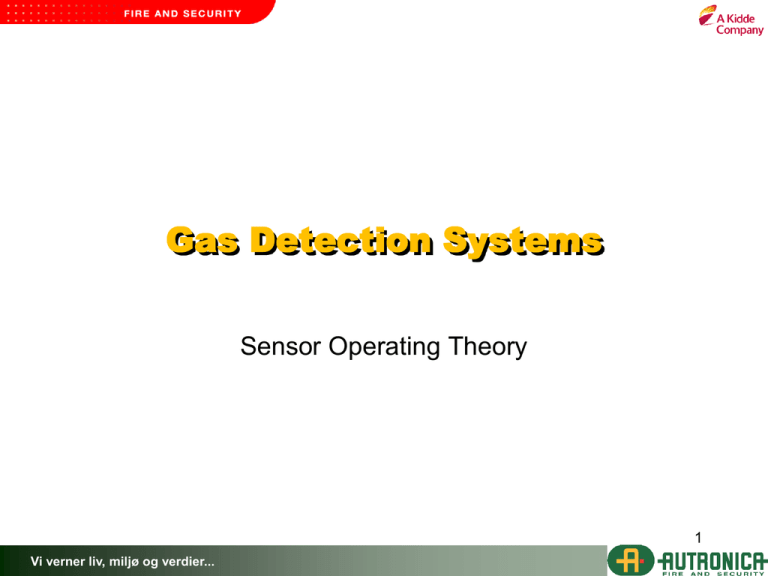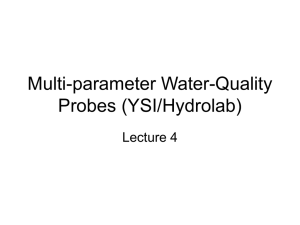Gas Detection Systems
advertisement

Gas Detection Systems Sensor Operating Theory 1 Vi verner liv, miljø og verdier... Gas/Vapor Hazards• • • • Flammable/Combustible Toxic Oxygen-deficiency Oxygen-enrichment 2 Vi verner liv, miljø og verdier... Gas Detection Objectives • Measure gas before hazardous concentration is present • Provide outputs for Emergency Action • Suitable for extreme environments (arctic, tropic, etc) • Complement to Flame Detection equipment • Cost-effective protection 3 Vi verner liv, miljø og verdier... Gas Sensing Technologies • • • • • • • Combustibles: Hydrogen Sulfide: Oxygen: Carbon Monoxide: Chlorine: Sulfur Dioxide: Nitrogen Dioxide: Catalytic and Infrared Electrochemical & MOS Electrochemical Electrochemical Electrochemical Electrochemical Electrochemical 4 Vi verner liv, miljø og verdier... Key Gas Detection Definitions • Measurement range: • • • • gas concentration at full scale sensor output Unit of Measurement: %LEL, PPM, or %volume Flashpoint: minimum temperature of liquid where enough vapor is given off to sustain a fire or explosion Vapor Density: tendency of a pure gas of vapor to rise or sink in clean air Calibration: process of matching transmitter signal to sensor measurement 5 Vi verner liv, miljø og verdier... Combustible Gases-Lower & Upper Limits* *No differentiation between the terms “Explosive” and “Flammable” as applied to the lower and upper limits of flammability Clean Air Too rich for ignition Too lean for ignition 50% Typical Combustible Gas Detector Range of Measurement Combustibles Lower Explosive Limit (LEL) Upper Explosive Limit (UEL) 6 Vi verner liv, miljø og verdier... Flammable Limits & Volumetric Equivalents Gas Type Methane Propane Hydrogen Hexane Methane Gas: 100% LEL= 75% 50% 25% 10% = = = = L.E.L. 5% 2.1% 4.0% 1.1% U.E.L. 15% 9.5% 75% 7.5% 5% by volume in air 3.75 2.5% 1.25% .50% “ “ “ “ 7 Vi verner liv, miljø og verdier... Catalytic Sensor Operation • • • • DET-TRONICS ALARM INCREASE SETUP DECREASE ACCEPT CAL/RESET Contact-based Destructive measurement Traditional method Only option for hydrogen gas detection • Used w/ transmitter module to provide 4-20 ma signal output • Typical life of 3-6 years • 2 year mfgr warranty 8 Vi verner liv, miljø og verdier... Catalytic Sensor Operation • • • • • Flammable gas • Active Element - Hot wire resistor coated with catalytic material Reference Element - Same as active but without catalyst Catalytic Oxidation of flammable gas generates heat & changes resistance of Active Element Explosion is prevented by Flame Arrestor Constant U or I power source required Must calibrate on start-up & routinely for accuracy 9 Vi verner liv, miljø og verdier... Catalytic Sensor Operation 10 Vi verner liv, miljø og verdier... Catalytic Sensor Limitations FAIL TO DANGER •Poisoning of Catalyst •Plugging of Flame Arrestor •Read Low @ High Gas Levels •Frequent Calibration •Service Life - Variable (Months) Vi verner liv, miljø og verdier... Infrared Combustible Detectors reference absorption band • Principal of Operation • Gases are Transparent to Visible Light BUT... • Gases are Strongly Opaque to Infrared Light at Some Wavelengths Vi verner liv, miljø og verdier... active absorption band Methane Propane Point Infrared Detector • Principle of Operation IR Transparent Windows Flammable hydrocarbon gas IR Source Optical Beamsplitter Permeable Gas Cell Reference Signal Detector Measurement Signal Detector Optical Filters Microprocessor and Electronics Gas Concentration (LEL) Vi verner liv, miljø og verdier... Fail-Safe Operation Active Reference Clean Air Active Failed Sensor IR Signal Level Active Active Reference Failed IR-Source IR Signal Level Active IR Signal Level Reference Failed Microprocessor = 0 mA IR Signal Level Vi verner liv, miljø og verdier... IR Signal Level Reference Hydrocarbon Gas Dirty Optics and Clean Air Reference Open Path IR Gas Detector • Instrumental Layout 10 - 60 m Optical Beamsplitter IR Source Measurement Signal Detector Flammable hydrocarbon gas Optical Filters Microprocessor and Electronics Reference Signal Detector Gas Concentration (LEL) Vi verner liv, miljø og verdier... Drivers for Optical Technology • Safety Driven Design Requirements – FAIL SAFE • No Unrevealed Sources of Failure – HIGH AVAILABILITY • Long Service Life • Low and Easy Maintenance Vi verner liv, miljø og verdier... Electrochemical Toxic Sensor Theory • • • • Specific to toxic gas type (H2S, CO, SO2, NO2, CL2 ) Consists of sensing(working), reference, and counter electrodes Vapor diffusion into capillary results in oxidation/ion reduction The signal (current) from the working electrode is converted to a voltage by operational amplifier Capillary Entrance O-ring Membrane Sensing Electrode Reference Electrode Electrolytic fluid Counter Electrode 17 Vi verner liv, miljø og verdier... Electrochemical Toxic Sensor Operation • • • • • • • All provide 4-20 ma signal output 0-100 ppm range typical Carbon monoxide ranges: 0-100, 0-500, or 0-1000 ppm- must specify Nitrogen dioxide range: 0-20 ppm Hydrophobic filter provides humidity protection All designed to meet X-proof req. except CL2, SO2 sensors (I.S. barrier required) All designed for calibration by a transmitter, controller or external control system. 18 Vi verner liv, miljø og verdier... Traditional Sensor Calibration • Matching transmitter output to raw sensor signal in clean air (zero) & mid-scale (span) conditions • Manual or Automatic depending upon transmitter type • Adjustments necessary if drifting has occurred • Requires compressed, accurate calibration gases • Always required @ start-up & after sensor replacement • Every 30-90 days thereafter typical 19 Vi verner liv, miljø og verdier... Gas Detector Calibration Requirements • Catalytic Sensors: • DEC IR Detectors: Field Calibration required for accuracy Routine calibration not required; Factory calibrated for methane only • Electrochemical Sensors: Field Calibration required for accuracy • DEC Open Path IR System: Routine calibration not required; Factory calibrated for methane only 20 Vi verner liv, miljø og verdier...









